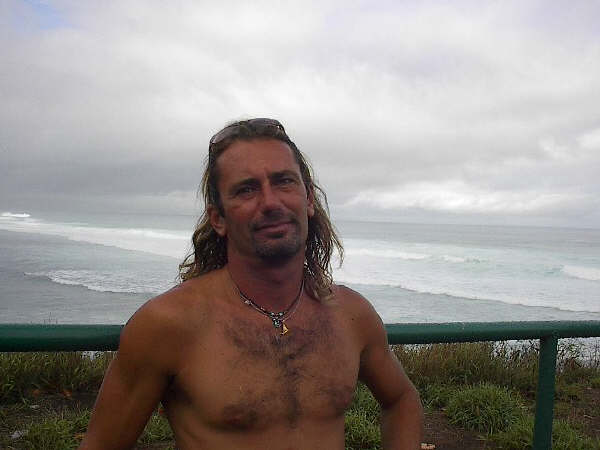This is how the windswell looked at Hookipa at sunset instead.

Significant buoy readings 3am:
Pauwela
4.7ft @ 8s from 66° (ENE)
Only windswell on the north shore today. Below I'm posting the very interesting readings at the different buoys of what I'm gonna call the "angular spreading" swell.
NW
1.2ft @ 15s from 135° (SE)
N
1.6ft @ 17s from 161° (SSE)
Mokapu
0.8ft @ 18s from 153° (SSE)
Lanai
2ft @ 17s from 200° (SSW)
W Hawaii
3.5ft @ 15s from 166° (SSE)
SE Hawaii
3.2ft @ 17s from 184° (S)
To elaborate on those apparently confusing (at least the direction) readings, it would help a lot to know the positions of all the buoys, so here's a little map to refresh your knowledge.
I put lines to indicate the swell direction at some of them. As you can see from the readings, the swell is almost straight south at the SE buoy. If you remember the original fetch (I put the map on yesterday's post), the swell at this point has already spread angularly a lot compared to the originating source and has changed its original direction that was around SW.
After hitting the SE buoy, the swell will continue to angularly spread and come from a slightly more easterly direction as it moves north.
Check how similar the directions are at the W and N buoys (166 and 161) and by the time the swell hits the NW buoy it is even more east (135).
This is a great graphical example of how swells fan out of their original direction of creation.

But why does the Lanai buoy indicate a direction of 200 instead? Because of that buoy is located close to the coastline and it registers the refraction of the swell over the southernmost tip of the island.
I tried to represent that below. The bottom long line indicates the supposed SSE approaching direction. Some energy will already refract around the east and west tips of Kahoolawe (I only showed the bending over the last one) and also around Makena point.
When the swell approaches Lanai (still supposingly from a SSE direction) it will refract over the land and become first S and then SSW, like indicated by the buoy.
In 15 years that I live here, I have shamingly never been in Lanai so I have no idea of how the coastline looks over there, but it looks to me like there might be some fun lefts over there these days.

The bottom line of this whole discussion is: there is a south swell!
I was talking with a blog reader yesterday and I couldn't believe he told me:"you surfed Lahaina? I didn't know there was a south swell?"
"What? Did you check the blog this morning?"
"Yes, but you wrote check the webcam..."
Ok guys, when I write check the webcam, I mean that you should do that if you want to have a more precise idea of the size of the waves at the harbor and the local wind conditions, NOT to see if there's a swell or not. That information is at the buoys.
So yes, there definitely is a south swell today and there will be tomorrow too.
How big? 2f 17s at the buoy. If that is not clear enough for you, you check the webcam or go surfing and try to memorize what that was.
It's not only about the size. It's the consistency, how many waves in a set (yesterday there were a lot of single wave sets), how clean, how powerful and fast. 2f 17s is a killer reading for the south shore and I'll be all over it today.
Sorry, can't make it more clear than that.
Current wind map shows a depressing lack of significant fetches.

Below is the map of today as forecasted 9 days ago on Sept. 12. I post this to show how unreliable these long term model runs are. Check the differences: that possible hurricane dissolved and that massive Tasman Sea fetch did not happen at all. Just FYI.

Mc2km maps not updated, these are the two models at the bottom of the Windguru page. It won't be particularly windy, but it all depends on the direction that the wind will have. The difference in the Haleakala amplification effect between 74 and 67 can be very significant.
I would recommend to check MC2km later when the maps will be up for a more reliable forecast.










No comments:
Post a Comment